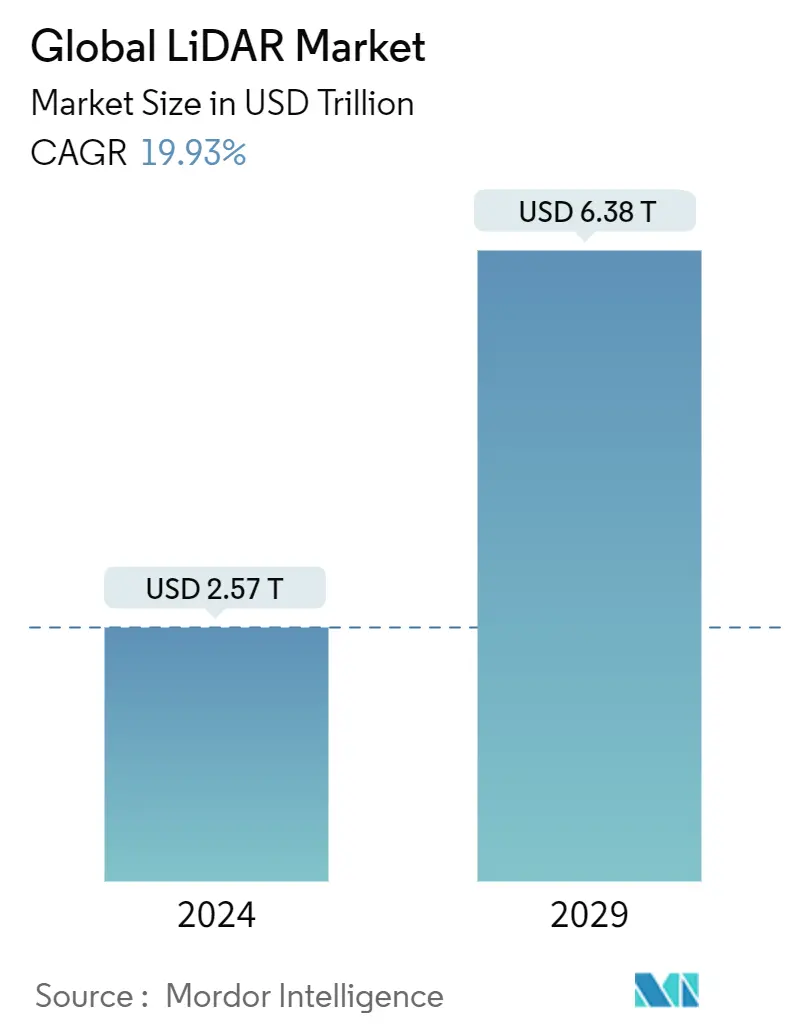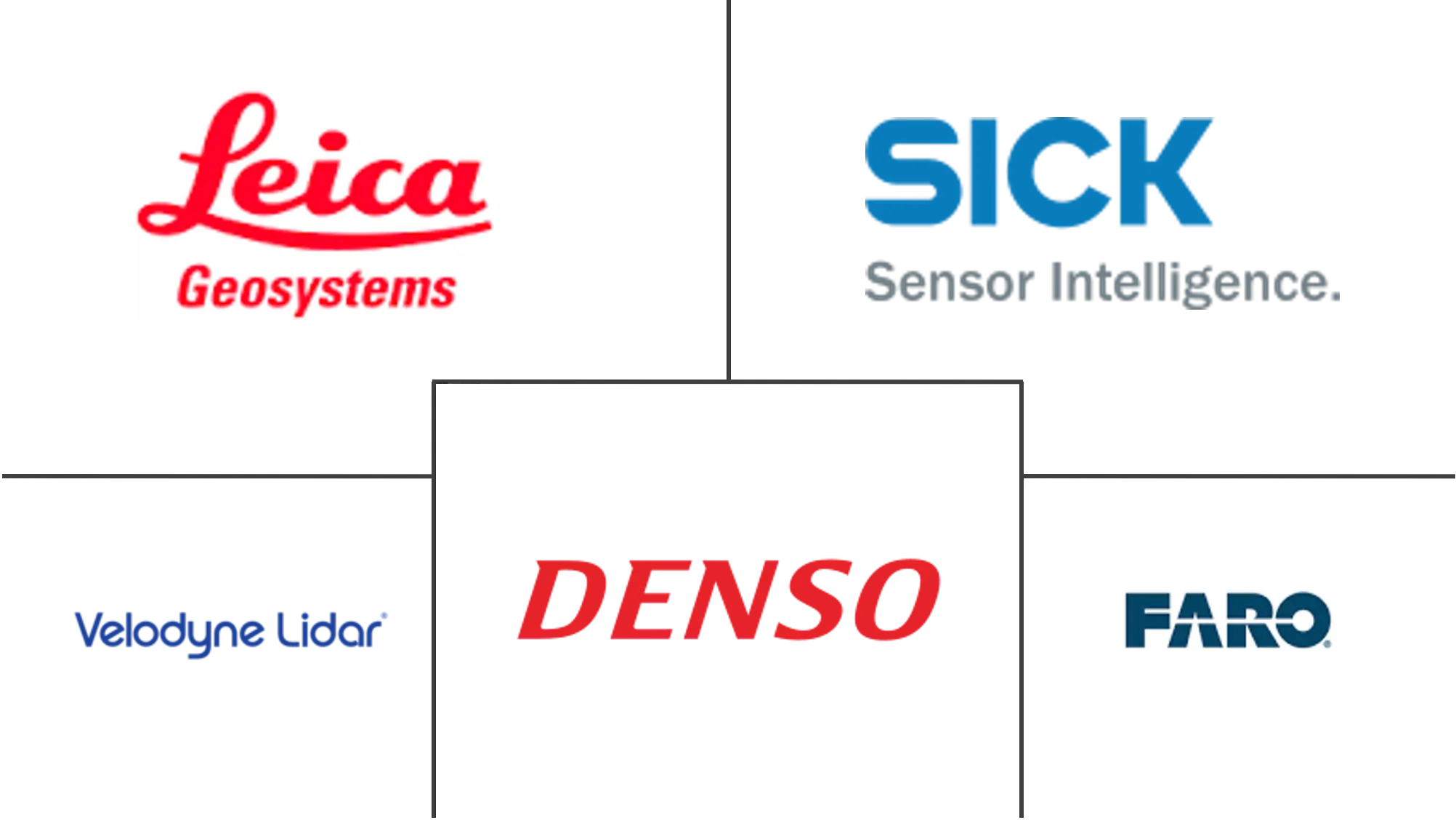Market Size of Global LiDAR Industry

| Study Period | 2019 - 2029 |
| Market Size (2024) | USD 2.57 Trillion |
| Market Size (2029) | USD 6.38 Trillion |
| CAGR (2024 - 2029) | 19.93 % |
| Fastest Growing Market | Latin America |
| Largest Market | Latin America |
Major Players
*Disclaimer: Major Players sorted in no particular order |
LiDAR Market Analysis
The Global LiDAR Market size is estimated at USD 2.57 trillion in 2024, and is expected to reach USD 6.38 trillion by 2029, growing at a CAGR of 19.93% during the forecast period (2024-2029).
One of the primary factors augmenting the LiDAR market growth is the increasing use of LiDAR systems in UAVs, the use of LiDAR in engineering and construction applications, the use of LiDAR in geographical information systems (GIS) applications, the emergence of 4D LiDAR, and the loosening of regulations surrounding the use of commercial drones in various applications. The market's expansion is being held back by safety concerns around UAVs and autonomous vehicles, as well as the accessibility of affordable and lightweight photogrammetry devices.
- Globally, and especially in developing nations, the size and scope of engineering and civil construction activities have greatly increased to accommodate the growing population. All stages of building activities, from surveying and mapping to conducting project feasibility studies, call for an increasing amount of technology. LiDAR technologies can easily and accurately give a detailed survey of vast areas. Additionally, global positioning system-assisted laser scanners and extremely sensitive cameras assist engineers in creating designs that meet project criteria and accurate feasibility assessments. Many LiDAR service providers have expanded as a result of this.
- In the oil and gas and mining sector, LiDAR technology allows scientists and mapping professionals to examine built and natural environments across a wide range of scales with greater accuracy, precision, and flexibility than ever before. The encouragement from the government in automation and the adoption of LiDAR in various government sector activities, like flood relief and management, are also driving the industry's growth. In India, the Transport Ministry mandated the use of LiDAR systems in surveying areas before constructing a new highway.
- Drones, or unmanned aerial vehicles (UAV’s), are witnessing growing adoption across many industries, owing to their low cost and vast array of applications. LiDAR drones were first developed as an instrument for studies on atmospheric composition, clouds, earth structures, and aerosols. They remain a powerful tool for climate observations around the world. Collecting this data, NOAA and other such research organizations operate these instruments to enhance understanding of climate change.
- The growing technological developments in the automotive sector is the major driving factor of the LiDAR market. The companies are looking for an amalgamation of various technologies, and LiDAR technology might play a vital role.
- High costs associated with the deployment of this technology are restraining the growth of this market. LiDAR systems are expected to become standard installations in autonomous drones and cars, expected to be deployed over the coming years. With fast-moving innovations in autonomous vehicle technologies and increasing support from the government, the early deployment of Level 5 autonomous vehicles is expected by the end of the forecast period. With the industry moving toward the complete autonomous range of vehicles, the dependence on LiDAR systems is growing.
- The COVID-19 outbreak affected industries around the world. The automotive industry is one of the significant adopters of LiDAR. The outbreak has resulted in the shutdown of various production plants impacting the demand. Semiconductor materials scarcity has further aggravated the situation.
LiDAR Industry Segmentation
LiDAR, which stands for Light Detection and Ranging, is a remote sensing method that uses light in the form of a pulsed laser to measure ranges (variable distances) to the Earth. These light pulses-combined with other data recorded by the airborne system- generate precise, three-dimensional information about the shape of the Earth and its surface characteristics.
The LiDAR market is segmented by application (robotic vehicle, ADAS, environment [topography, wind, and agriculture and forestry], and industrial), type (aerial and terrestrial), and geography (North America, Europe, Asia Pacific, Latin America, Middle East and Africa). The report offers the market size in value terms in USD for all the abovementioned segments.
| Application | |||||
| Robotic Vehicles | |||||
| ADAS | |||||
| |||||
| Industrial |
| Type | |
| Aerial (Topographic and Bathymetric) | |
| Terrestrial (Mobile and Static) |
| Geography | |
| North America | |
| Europe | |
| Asia Pacific | |
| Latin America | |
| Middle East and Africa |
Global LiDAR Market Size Summary
The LiDAR market is poised for significant growth, driven by its increasing application across various sectors such as engineering, construction, and geographical information systems. The technology's integration into unmanned aerial vehicles (UAVs) and its emerging role in 4D LiDAR systems are key factors propelling market expansion. Despite challenges like safety concerns and the high costs of deployment, the market is benefiting from advancements in autonomous vehicle technologies and supportive government policies. The automotive industry, in particular, is a major adopter of LiDAR, utilizing it for advanced driver assistance systems and self-driving cars, which are expected to become standard in the near future.
In addition to automotive applications, LiDAR technology is gaining traction in sectors like oil and gas, mining, and agriculture, especially in regions like Latin America, where dense forest cover and agricultural lands present unique opportunities. The technology's ability to create detailed 3D models and penetrate tree cover makes it invaluable for environmental monitoring and resource management. The market is characterized by a fragmented landscape with numerous players engaging in strategic partnerships and technological innovations to maintain a competitive edge. Key industry players include Sick AG, Teledyne Optech, and Velodyne LiDAR, among others, who are actively contributing to the market's dynamic growth through collaborations and product launches.
Global LiDAR Market Size - Table of Contents
-
1. MARKET INSIGHTS
-
1.1 Market Overview
-
1.2 Industry Attractiveness - Porter's Five Forces Analysis
-
1.2.1 Threat of New Entrants
-
1.2.2 Bargaining Power of Buyers
-
1.2.3 Bargaining Power of Suppliers
-
1.2.4 Threat of Substitutes
-
1.2.5 Intensity of Competitive Rivalry
-
-
1.3 Market Drivers
-
1.3.1 Fast Paced Developments and Increasing Application of Drone
-
1.3.2 Increasing Adoption in the Automotive Industry
-
-
1.4 Market Challenges
-
1.4.1 High Cost of The LiDAR Systems
-
-
1.5 Industry Value Chain
-
1.6 Technology Snapshot
-
1.6.1 Measurement Process Options
-
1.6.2 Laser Options
-
1.6.3 Beam Steering Options
-
1.6.4 Photodetector Options
-
-
1.7 Impact of COVID-19 on the Market
-
-
2. MARKET SEGMENTATION
-
2.1 Application
-
2.1.1 Robotic Vehicles
-
2.1.2 ADAS
-
2.1.3 Environment
-
2.1.3.1 Topography
-
2.1.3.2 Wind
-
2.1.3.3 Agriculture and Forestry
-
-
2.1.4 Industrial
-
-
2.2 Type
-
2.2.1 Aerial (Topographic and Bathymetric)
-
2.2.2 Terrestrial (Mobile and Static)
-
-
2.3 Geography
-
2.3.1 North America
-
2.3.2 Europe
-
2.3.3 Asia Pacific
-
2.3.4 Latin America
-
2.3.5 Middle East and Africa
-
-
Global LiDAR Market Size FAQs
How big is the Global LiDAR Market?
The Global LiDAR Market size is expected to reach USD 2.57 trillion in 2024 and grow at a CAGR of 19.93% to reach USD 6.38 trillion by 2029.
What is the current Global LiDAR Market size?
In 2024, the Global LiDAR Market size is expected to reach USD 2.57 trillion.

